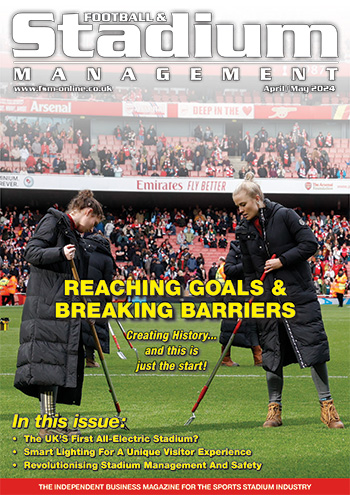A Century Of Wembley Stadium

We spoke to Paul Collins, Communications Manager at Wembley Stadium to explore how the stadium’s facilities have changed over the last century and provide an insight to the teams who look after the day‑to‑day management of the nation’s most iconic venue.
What have been the biggest changes at the stadium over the last 100 years?

By the close of the 20th Century, it was clear that the old stadium was outdated and not going to be suitable for the future. Updating the old stadium was not a viable option. We had to start afresh.
In 2007 the new stadium opened with variety of new features including unobstructed views, wider concourses, more toilets, food kiosks, additional wheelchair spaces, contemporary press facilities and a state‑of‑the art sound and lighting system. It was a stadium built for the future and was crowned by the 133‑metre‑tall arch, which spans the entire stadium and is visible right across London.
How has the ‘fan experience’ changed and developed, with new demands across different audiences at Wembley?
When people come to Wembley Stadium they do so for a major event. It’s a big occasion and they want to make a day of it so it is important we support that by creating the best customer experience we can.
That experience starts with their first contact – so it might be the website, the ticket office, or our social channels. We need to make sure they have all the information they need to ensure their day out is the best it can be. We call it the sofa to seat journey. Once they get to Wembley is starts again. Fan Zones outside the stadium are used in a variety of ways depending on the audience. So, what you might see at an England men’s fixture will not necessarily be the same as what you get at an England Women’s fixture or Rugby League final.
You want people to go home feeling like they have had the best day out ever. We believe Wembley now provides the ultimate, unforgettable, fan experience and we will continue to develop it each year to improve that experience.
How has the service had to change within the Stadia to accommodate these different events?
To deliver an exceptional fan experience you need to have the right equipment, and the right services for a particular audience.
In 2019 we upgraded all our audio equipment inside the stadium to ensure the person sitting on row 1 of Level 1 had the same audio experience as the person sitting on row 48 of Level 5. The new system means we can alter the array of speakers for each event. During a sports event the arrays are in their default position, on an axis with the spectators seating position. For a concert they can then be rotated in line with the stage.
The sound is noticeably better now, and fans are more engaged due to the clarity of the system. Feedback from visiting concert show sound companies and promotors has also been very positive. Elsewhere, if you take a walk along our concourses, you will see how our food and drink options have changed. We now have kiosks selling everything from specialised gins, craft beers, sweets, champagne and pick n mix. It is no longer just about pints and pies (although you can still get that if you want).
How has security developed over the years, particularly since the Euro finals?

We recently completed Phase One of that project, including upgrades to accessibility turnstile entrances and our Club Wembley and staff entrances. We also installed more 24‑hour monitored CCTV cameras. Work will begin shortly on Phase Two, which will see the installation of a new boundary fence (3.0‑3.4m high) and other additional measures which will ensure Wembley continues to be a safe and secure venue for all our guests.
How has the movement of fans and visitors within Wembley Stadium has developed?

A big criticism of the old Wembley was the concourses were very cramped. The problem was exacerbated by the lack of toilets which caused large queues and generally made it difficult to move around.
The new stadium has larger concourse areas which allow people to move around the entire stadium and we have more toilets (in fact there are 2,618 in total – more than any other venue in the world) that reduces queue times. These can be switched between male and female depending on the audience make‑up.
We have 26 lifts which help people move between levels and there is more leg room in each individual seat than there was in the Royal Box of the old stadium. Digital signage has also helped. We have over 240 screens we can utilise to provide alternative ways to leave. These screens can be updated in real‑time and targeted to specific areas of the stadium.
How do the offices behind the scenes integrate with life outside of gameday?
We have office space for over 350 staff from The FA, Wembley Stadium, London FA and The Football Foundation. We are like any other office building with the need to heat, cool and clean the building appropriately.
We have an on‑site FM team who manage the operation 24/7, 365 days a year, and we utilise the stadium’s facilities to accommodate staff requirements. For example, The Three Lions restaurant, which is a hospitality suite on event days, becomes a staff restaurant during the week.
There is minimal interruption from other activity that goes on, such as public tours, corporate events, or filming in the stadium. In fact, the only time staff might notice something going on is if they look out towards the pitch or hear a band rehearsing.
If we have an event on in the evening (a concert or football match) then we do ask staff to leave earlier than normal, just for ease as much as anything. That is when we switch from being an office to a venue and that means additional security protocols are in place and certain exits might be restricted. It can also be a pain getting home when you have 90,000 people coming in the opposite direction.
How has the hospitality changed and developed over the years?

All hospitality is managed by Delaware North who have huge experience of providing such a service at stadiums across the world. They have a team permanently based at the stadium and work with specialist agencies to bring on extra staff when required. For a blue‑ribbon event like the FA Cup Final we might easily see an additional 2,000 staff come on to site.
It is also vital that we can offer a variety of different options. More and more people now want to enhance their match‑day or event experience by adding on hospitality options. Our Club Wembley offering allows them to do this at a variety of different levels. Today’s Wembley Stadium is all about providing different options for different audiences.
With advances in access control and security how has visitor access changed over the last century?
When Wembley first opened in 1923 it had 100 turnstiles. These were the original wrought‑iron, ‘rush preventive turnstiles’ which were manually operated and ‘clicked’ every time someone passed through. They were very, very heavy and The National Museum of Football still has one of the original turnstiles in its collection. The new stadium has 164 turnstiles including those with widened access for guests with accessibility needs.
Ticketing is entirely digital with barcode readers on all entrance points. Print at home is still the most popular method for ticket delivery, but we are also set up for third‑party digital ticketing. As more event owners move to an app based ticketing solution it is important our systems can integrate with their technology.
For example, the EURO 2020 and EURO 2022 matches played at Wembley were all digital tickets via the UEFA App. Over the next few years, we hope to introduce our own app which will include digital ticketing.
How has Wembley’s net‑zero commitment affected change within the stadium?

Through our partnership with Veolia, we have also been a ‘zero‑waste‑to‑landfill’ venue since 2010. Considering that our events here at Wembley can produce up to 40 tonnes of waste, it is important we ensure this waste is managed in the most appropriate way.
Looking towards the future and the next 100 years what are the challenges for maintaining Wembley and ensuring it remains state‑of‑the‑art for the future?
The stadium has been open and operating for 16 years now and several components are reaching the end of their natural life cycle. We have an annual capex programme for upgrades and we are already investing in new processes for ordering food and drink, wayfinding and ticketing to ensure we stay state‑of‑the‑art.
Earlier this year we embarked on a seat replacement programme. We have also started work on replacing 26 internal lifts and next year we will be looking to change our two, in‑bowl scoreboards (192M2) ahead of the Champions League Final here next summer. We never sit still or rest on our laurels and are constantly investing in the stadium to ensure we remain world class.
Click the article to enlarge it.
















































